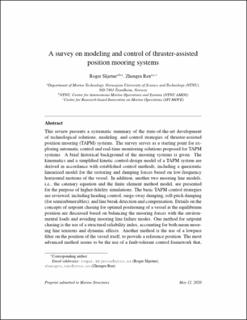| dc.contributor.author | Skjetne, Roger | |
| dc.contributor.author | Ren, Zhengru | |
| dc.date.accessioned | 2021-03-08T12:30:30Z | |
| dc.date.available | 2021-03-08T12:30:30Z | |
| dc.date.created | 2020-07-21T21:56:12Z | |
| dc.date.issued | 2020 | |
| dc.identifier.citation | Marine Structures. 2020, 74 . | en_US |
| dc.identifier.issn | 0951-8339 | |
| dc.identifier.uri | https://hdl.handle.net/11250/2732170 | |
| dc.description.abstract | This review presents a systematic summary of the state-of-the-art development of technological solutions, modeling, and control strategies of thruster-assisted position mooring (TAPM) systems. The survey serves as a starting point for exploring automatic control and real-time monitoring solutions proposed for TAPM systems. A brief historical background of the mooring systems is given. The kinematics and a simplified kinetic control-design model of a TAPM system are derived in accordance with established control methods, including a quasistatic linearized model for the restoring and damping forces based on low-frequency horizontal motions of the vessel. In addition, another two mooring line models, i.e., the catenary equation and the finite element method model, are presented for the purpose of higher-fidelity simulations. The basic TAPM control strategies are reviewed, including heading control, surge-sway damping, roll-pitch damping (for semisubmersibles), and line break detection and compensation. Details on the concepts of setpoint chasing for optimal positioning of a vessel at the equilibrium position are discussed based on balancing the mooring forces with the environmental loads and avoiding mooring line failure modes. One method for setpoint chasing is the use of a structural reliability index, accounting for both mean mooring line tensions and dynamic effects. Another method is the use of a lowpass filter on the position of the vessel itself, to provide a reference position. The most advanced method seems to be the use of a fault-tolerant control framework that, in addition to direct fault detection and isolation in the mooring system, incorporates minimization of either the low-frequency tensions in the mooring lines or minimization of the reliability indices for the mooring lines to select the optimal directions for the setpoint to move. A hybrid (or supervisory switching) control method is also presented, where a best-fit control law and observer law are automatically selected among a bank of control and observer algorithms based on the supervision of the sea-state and automatic switching logic. | en_US |
| dc.language.iso | eng | en_US |
| dc.publisher | Elsevier | en_US |
| dc.relation.uri | https://www.ntnu.edu/amos | |
| dc.rights | Attribution-NonCommercial-NoDerivatives 4.0 Internasjonal | * |
| dc.rights.uri | http://creativecommons.org/licenses/by-nc-nd/4.0/deed.no | * |
| dc.subject | Dynamisk Posisjonering | en_US |
| dc.subject | Dynamic Positioning | en_US |
| dc.subject | Marin kybernetikk | en_US |
| dc.subject | Marine cybernetics | en_US |
| dc.subject | Bevegelsesstyring | en_US |
| dc.subject | Motion control | en_US |
| dc.title | A survey on modeling and control of thruster-assisted position mooring systems | en_US |
| dc.type | Peer reviewed | en_US |
| dc.type | Journal article | en_US |
| dc.description.version | acceptedVersion | en_US |
| dc.subject.nsi | VDP::Offshoreteknologi: 581 | en_US |
| dc.subject.nsi | VDP::Offshore technology: 581 | en_US |
| dc.source.pagenumber | 19 | en_US |
| dc.source.volume | 74 | en_US |
| dc.source.journal | Marine Structures | en_US |
| dc.identifier.doi | 10.1016/j.marstruc.2020.102830 | |
| dc.identifier.cristin | 1820085 | |
| dc.relation.project | Norges forskningsråd: 237929 | en_US |
| dc.relation.project | Norges forskningsråd: 223254 | en_US |
| dc.description.localcode | "© 2020. This is the authors’ accepted and refereed manuscript to the article. Locked until 18.8.2022 due to copyright restrictions. This manuscript version is made available under the CC-BY-NC-ND 4.0 license http://creativecommons.org/licenses/by-nc-nd/4.0/ " | en_US |
| cristin.ispublished | true | |
| cristin.fulltext | postprint | |
| cristin.fulltext | original | |
| cristin.fulltext | postprint | |
| cristin.qualitycode | 2 | |

